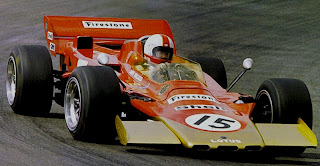Turbine powered automobiles have been tried and tested many times as a replacement to the conventional piston engine. Essentially a jet-engine mated to a mechanical drive shaft, turbines allow a vast power curve and relative simplicity. The idea became gained popularity in the late 1950's "Jet Age" and was experimented with heavily by Chrysler in particular. They proved rather impractical on street cars though for various reasons like extreme heat, noise, and high fuel consumption. Even Rover took the technology to LeMans in 1963 with Graham Hill and Richie Ginther, but that of course is another story.
Andy Granatelli's STP-Paxton turbine-powered special came close to winning the 1967 "500" at the hands of Parnelli Jones before dropping out 10 laps from the finish due to a bearing failure in it's unique 1-speed drivetrain. The turbine's wide operating speed range meant changing ratios was unnecessary, but power was sent to the ground with a bespoke Ferguson (as in Massy-Ferguson tractors) four-wheel-drive system. Though it didn't win, Granatelli was sold on the potential of the formula.
(The STP-Paxton chassis and engine)
The next year, Lotus joined STP's efforts with their vast racing expertise and built on Granatelli's idea. This project became known as the Lotus 56. As if the 500+ horsepower Pratt & Whitney turbine (designed for helicopters) wasn't radical or innovative enough, designer Maurice Philippe clothed the car in an unusual new aerodynamic "wedge" shape. Unlike the 56's predecessor, which placed the driver beside the engine, the Lotus had its turbine was mounted in the center behind the driver, which allowed for a completely symmetrical and balanced chassis. Perhaps even early in development, Lotus had plans for the four-wheel-drive car on tracks that were not just ovals. In any case, it seemed like a very promising package and STP's Granatelli was eager for his team to have a victory at Indy.
(Granatelli and his 1967 effort with Chapman, Clark, and the Lotus)
(Spence's fatal crash in the Lotus 56)
(David Walker in 1971 at the wheel of a 56B - note addition of wings)
(Fittipaldi in Italy with later livery - front wings removed for this high-speed track)
The 56's career was finally over. Lotus had already carried-over the "wedge" design to the very successful 72 F1 car, but turbines whirred away into the history books.







